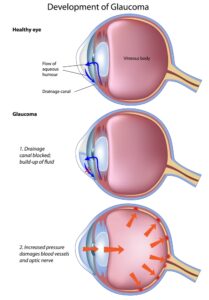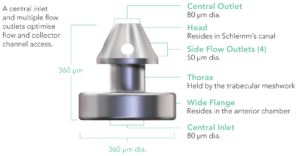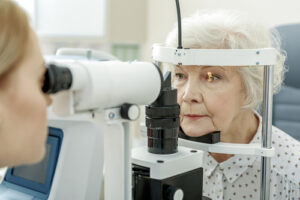Glaucoma is one of the leading causes of blindness in Americans over the age of 60. Glaucoma is an eye condition that occurs when the fluid in the eye, known as aqueous humor, does not properly drain.
Keep reading to learn more about glaucoma and how eye doctors treat this eye condition.
Are There Signs of Glaucoma?

As fluid from the aqueous humor collects, it causes increased pressure on the eye, damaging the optic nerve. If left untreated, glaucoma can cause vision impairment, from blind spots to permanent blindness.
Blind spots are an early indicator of glaucoma, though often, by the time patients begin noticing blind spots, serious damage to the optic nerve fibers has already occurred.
There are two major types of glaucoma: primary open-angle glaucoma and angle-closure glaucoma, sometimes known as closed-angle glaucoma or narrow-angle glaucoma.
Primary Open-Angle Glaucoma
Primary open-angle glaucoma is the most commonly diagnosed type of glaucoma. This type of glaucoma happens gradually, as the eye cannot drain fluid from the eye as it should.
When this occurs, it causes pressure to build up in the eye. This type of glaucoma is painless and does not cause immediate vision changes as it causes pressure to build up.
Angle-Closure Glaucoma
Angle-closure glaucoma occurs when the iris blocks the eye drainage area. If this happens, it traps fluid at the front of the eye, resulting in a rapid pressure buildup.
While many people with angle-closure glaucoma develop it slowly, they are unaware they have glaucoma until they experience an “acute attack,” which is the sudden onset of angle-closure glaucoma symptoms.
Symptoms of an acute attack include sudden and severe eye pain, blurred vision, headache, nausea, and redness of the eye. If you experience these symptoms, it is a true eye emergency. You should seek medical attention right away.
Preserve Your Vision with Early Detection of Glaucoma
As with many eye conditions, early detection of glaucoma is the best way to preserve your vision. Scheduling regular comprehensive eye exams with your eye doctor is the best way to ensure any eye problems you may have to receive early diagnosis and treatment.
If you are diagnosed with glaucoma, there are treatments available that can slow and even prevent vision loss. While the damage caused by glaucoma is irreversible, it does not have to inevitably lead to vision loss with today’s advanced glaucoma treatments.
Glaucoma treatment’s primary goal is to reduce intraocular pressure to protect and prolong the functionality of the nerves inside your eye. Treatment options include prescription eye drops, oral medications, surgery, or a combination of these treatments.

Depending on how far advanced a patient’s glaucoma is, often an eye doctor will try non-surgical treatments first. Many prescription eye drops can reduce eye pressure by increasing the outflow of fluid in the eye, reducing the production of fluid in the eye, or reducing the body’s production of fluids that run through the eye.
An eye doctor may also prescribe an oral medication, usually a carbonic anhydrase inhibitor, that works in conjunction with a prescription eye drop to reduce eye pressure. If eye drops or oral medications cannot control eye pressure, your eye doctor may advise you to consider a surgical treatment option. While more invasive, surgical options are often the most effective way to prevent the damaging effects of glaucoma.
At Batra Vision Center, we can offer our patients the following surgical options:
Trabeculectomy
A trabeculectomy creates a new pathway for fluid inside the eye, allowing for more effective drainage. While a trabeculectomy cannot restore lost vision, it can prevent further loss of vision and is used to treat many types of glaucoma.
Valve Surgery
Often used to enhance the results of a trabeculectomy, valve surgery involves the implantation of a small tube into the front of the eye, which assists in fluid drainage and the reduction of eye pressure.
Laser Surgery
With glaucoma laser surgery, your eye doctor uses a laser beam to open the fluid channels of the eye to increase fluid drainage. Laser surgery can be used as a one-time treatment or an ongoing treatment to manage glaucoma symptoms.
iStent

iStent is one of the newest and most innovative glaucoma treatments available. An iStent is a very tiny medical device implanted in the eye.
It reduces eye pressure by creating a permanent opening for fluid in the eye to drain. Many patients who opt for iStent implants can reduce or eliminate their need for prescription glaucoma medications.
Aside from medical treatments, your eye doctor may advise you of other things you can do to treat or manage your glaucoma. One of the most important things you can do is strictly adhere to your glaucoma medication schedule.
Managing Glaucoma
Setting an alarm on your phone can help you stay on track with prescribed medications to prevent further vision loss. Maintaining a healthy lifestyle is another thing you can do to help control glaucoma.
Exercising regularly and eating foods that contribute to healthy eyes are good habits that promote health inside and out. Prioritizing eye care is also vital in ensuring the management of glaucoma symptoms and the overall health of your eyes.

The best way to do this is to schedule regular comprehensive eye exams with an eye care provider you can trust, like Batra Vision Center! At Batra Vision, our eye care specialists have extensive experience diagnosing and treating all forms and stages of glaucoma.
If you are experiencing the signs or symptoms of glaucoma, we encourage you to schedule an appointment to discuss the many treatment options available to our glaucoma patients. With the right eye care team behind you, a glaucoma diagnosis does not have to mean the loss of your precious vision.
Schedule your appointment at Batra Vision in San Leandro, CA, today!

 Follow Us!
Follow Us!